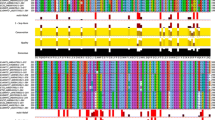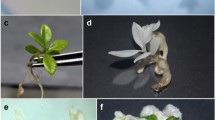Abstract
The caffeine biosynthetic pathway in coffee plants has been proposed to involve three distinct N-methyltransferases, xanthosine methyltransferase (XMT), 7-N-methylxanthine methyltransferase (MXMT; theobromine synthase), and 3,7-dimethylxanthine methyltransferase (DXMT; caffeine synthase). We previously isolated all corresponding cDNAs designated as CaXMT1, CaMXMT1, CaMXMT2 and CaDXMT1, respectively, and showed that caffeine was indeed synthesized in vitro by the combination of their gene products. In order to regulate caffeine biosynthesis in planta, we suppressed expression of CaMXMT1 by the double stranded RNA interference (RNAi) method. For this purpose, we first established a protocol for efficient somatic embryogenesis of Coffea arabica and C. canephora, and then Agrobacterium-mediated transformation techniques. The RNAi transgenic lines of embryogenic tissues derived from C. arabica and transgenic plantlets of C. canephorademonstrated a clear reduction in transcripts for CaMXMT1 in comparison with the control plants. Transcripts for CaXMT1 and CaDXMT1 were also reduced in the most cases. Both embryonic tissues and plantlets exhibited a concomitant reduction of theobromine and caffeine contents to a range between 30% and 50% of that of the control. These results suggest that the CaMXMT1-RNAi sequence affected expression of not only CaMXMT1 itself, but also CaXMT1and CaDXMT1, and that, since the reduction in theobromine content was proportional to that for caffeine, it is involved in the major synthetic pathway in coffee plants. The results also indicate that the method can be practically applied to produce decaffeinated coffee plants.
Similar content being viewed by others
References
Acuna, R., Bassuner, R., Beilinson, V., Cortina, H., Cadena-Gomez, G., Montes, V. and Nielsen, N.C. 1999. Coffee seeds contain 11S storage proteins. Physiol. Plant 105: 122-131.
Ashihara, H., Monterio, A.M., Moritz, T., Gillies, F.M. and Crozier, A. 1996a. Catabolism of caffeine and related purine alkaloids in leaves of Coffea arabica L. Planta 198: 334-339.
Ashihara, H., Monterio, A.M., Gillies, F.M. and Crozier, A. 1996b. Biosynthesis of caffeine in leaves of coffee. Plant Physiol. 111: 747-753.
Ashihara, H. and Crozier, A. 2001. Caffeine: A well known but little mentioned compound in plant science. Trends Plant Sci. 6: 407-413.
Ashihara, H. and Crozier, A. 1999. Biosynthesis and metabolism of caffeine and related purine alkaloids in plants. Adv. Bot. Res. 30: 118-205.
Hashimoto, T. and Yamada, Y. 2003. New genes in alkaloid metabolism and transport. Curr. Opin. Biotech. 14: 163-168.
Hatanaka, T., Arakawa, O., Yasuda, T., Uchida, N. and Yamaguchi, T. 1991. Effect of plant growth regulators on somatic embryogenesis in leaf cultures of Coffea canephora. Plant Cell Rep. 10: 179-182.
Hatanaka, T., Choi, Y.E., Kusano, T. and Sano, H. 1999. Transgenic plants of coffee Coffea canephora from embryogenic callus via Agrobacterium tumefaciens-mediated transformation. Plant Cell Rep. 19: 106-110.
Hood, E.E., Halmer, G.L., Fraley, R.T. and Chilton, M.D. 1986. The hypervirulence analysis of the Agrobacterium tumefacience A281 is encoded in a region pTIB0542 outside of T-DNA. J. Bacteriol. 168: 1291-1301.
Marraccini, P., Deshayes, A., Petiard, V. and Rogers, W.J. 1999. Molecular cloning of the complete 11S seed storage protein gene of Coffea arabica and promoter analysis in transgenic tobacco plants. Plant Physiol. Biochem. 37: 273-282.
Mizuno, K., Okuda, A., Kato, M., Yoneyama, N., Tanaka, H., Ashihara, H. and Fujimura, T. 2003. Isolation of a new dual-functional caffeine synthase gene encoding an enzyme for the conversion of 7-methylxanthine to caffeine from coffee (Coffea arabica L.). FEBS Lett. 534: 75-81.
Murashige, T. and Skoog, F. 1962. A revised medium for rapid growth and bioassays with tabacco tissue cultures. Physiol. Plant 15: 473-479.
Ogawa, M., Herai, Y., Koizumi, K., Kusano, T. and Sano, H. 2001. 7-Methylxanthine methyltransferase of coffee plants. J. Biol. Chem. 276: 8213-8218.
Ogita, S., Uefuji, H., Yamaguchi, Y., Koizumi, N. and Sano, H. 2003. Producing decaffeinated coffee plants. Nature 423: 823.
Ohta, S., Mita, S., Hattori, T. and Nakamura, K. 1990. Construction and expression in tobacco of a β-glucuronidase (GUS) reporter gene containing an intron within the coding sequence. Plant Cell Physiol. 31: 805-813.
Rogers, W.J., Bezard, G., Deshayes, A., Meyer, I., Petiard, V. and Marraccini, P. 1999. Biochemical and molecular characterization and expression of the 11S-type storage protein from Coffea arabica endosperm. Plant Physiol. Biochem. 37: 261-272.
Uefuji, H., Ogita, S., Yamaguchi, Y., Koizumi, N. and Sano, H. 2003. Molecular cloning and functional characterization of three distinct N-methyltransferases involved in the caffeine biosynthetic pathway in coffee plants. Plant Physiol. 132: 372-380.
Vaistij, F.E., Jones, L. and Baulcombe, D.C. 2002. Spreading of RNA targeting and DNA methylation in RNA silencing requires transcription of the target gene and a putative RNA-dependent RNA polymerase. Plant Cell 14: 857-867.
van Boxtel, J. and Berthouly, M. 1996. High frequency somatic embryogenesis from coffee leaves. Plant Cell Tiss. Org. Cult. 44: 7-17.
Author information
Authors and Affiliations
Rights and permissions
About this article
Cite this article
Ogita, S., Uefuji, H., Morimoto, M. et al. Application of RNAi to confirm theobromine as the major intermediate for caffeine biosynthesis in coffee plants with potential for construction of decaffeinated varieties. Plant Mol Biol 54, 931–941 (2004). https://doi.org/10.1007/s11103-004-0393-x
Issue Date:
DOI: https://doi.org/10.1007/s11103-004-0393-x




